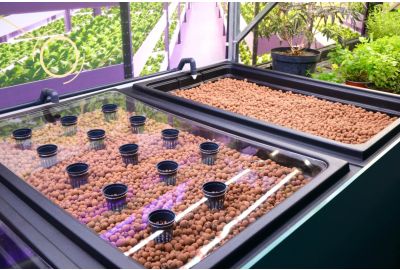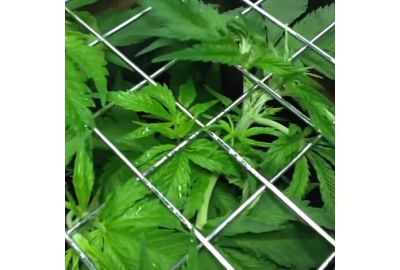DIY Vertical Hydroponics System For Weed: How To Set Up A Fantastic One
There have been many advancements in the cannabis gardening world, and vertical hydroponics is one of those innovative pursuits. You may have heard people talking about it and are wondering what it entails.
We’re here to help you understand what it is, how it works, and how you can set up your own vertical hydroponic garden.
What is a vertical hydroponics garden?
A vertical hydroponic garden is an integration of two cultivation methods: hydroponics and vertical farming.
Hydroponics is a growing system that doesn’t use soil. It feeds minerals and essential nutrients to the plants through the water.
Vertical farming saves space, where gravity plays a major role in water flow.
Vertical hydroponics comes in handy when you don’t have enough ground surface or horizontal floor area. You’ll grow your crops in vertically stacked layers.
How does a vertical hydroponic system work?
A vertical hydroponic system has a reservoir and a tower. A tube connected to the reservoir and a hydroponic pump transports water to the top to flow downwards.
The system relies on gravity to maintain a steady and continuous circulation of nutrient-rich water to several vertically stacked layers.
There are two main designs for these systems.
A hydroponic gardening tower utilizes a single tube to supply one major crop with the same nutrients. If multiple plants are grown on different layers of the tower, numerous channels are required.
Each channel is connected to a separate water source with specific nutrient levels, and vertical hydroponics allow growers to regulate water flow based on the strain’s specific needs.
The plants are placed at a 45-degree angle in netted cups or pots. As such, the cannabis roots access water easily for optimal nourishment as required.
A zig-zag vertical hydroponic system utilizes multiple pipes arranged in a zig-zag or diagonal manner. Netted cups or pots are placed in pipe holes at a 90-degree angle.
Water is pumped to the top first, then flows down. In an indoor system where light may be a concern, multiple light panels are placed at each pipe to ensure equal and adequate light distribution.
Now that you know what vertical hydroponics is and how it works, let’s look at the pros and cons.
What are the advantages of vertical hydroponics systems?
There are several advantages to using vertical hydroponics systems, and many people have praised the setup for the following reasons:
Perfect for small grow areas
Vertical farming maximizes grow space, allowing a space that usually holds only one plant to hold three or more plants.
Depending on the available floor-to-ceiling height, you could grow even more plants in your vertical hydroponic garden than you’d usually be able to.
Plant roots in this system don’t spread out as much searching for nutrients compared to growing them in soil. The roots are suspended directly in a nutrient-rich solution, so growing crops closer is possible, saving space.
You can build a vertical hydroponic system on a balcony, in a compact room, or in your front yard.
To put it into perspective: A space with measurements of 8ft x 8ft x 8ft can be maximized for over 150ft of usable space.
Higher yields
In a small space where you’d usually expect smaller yields, having multiple layers of plants means a more substantial harvest. You can stack more layers on top of each other than you usually could.
With a vertical hydroponic garden (especially indoors), you can control light distribution, temperature, air composition, and pest exposure. As such, you can maximize crop growth rates, yield, and quality.
Indoor systems also allow you to grow cannabis crops year-round for perpetual harvests.
Minimal maintenance and wastage
Vertical hydroponics requires little maintenance due to the self-sufficient setup.
You don’t need to worry about manually feeding your marijuana plants with this enclosed nutrient and water flow system.
Hydroponic minerals are fast-release. Cannabis plants uptake those minerals quickly, which means faster growth for optimal results in your vertical hydroponic garden.
As long as the system is set up to provide the right amount of water and nutrients, you can sit back and watch the magic happen.
The vertical hydroponic system is automated. The constant circulation of water and nutrients means minimum runoff or wastage of essential resources.
Easier to regulate
A hydroponics system eliminates the hassles of balancing soil elements and hydro nutrient solutions.
It allows you to correct factors such as incorrect pH or TDS levels by emptying the reservoir. The hydroponic vertical garden easily replenishes water and nutrients without disrupting the feeding cycle.
In this soil-free and controlled environment, the risks of pests, weeds, and plant diseases are minimized. You’ll use less fungicide, pesticide, and chemical fertilizer, which improves crop health and safety.
Reduced electricity cost
With an indoor vertical hydroponic system, the vegetative stages only require 18 hours of light per day over a few days.
Electricity costs are reduced because you save hours on lighting. The hydroponic pump doesn’t use much electricity, either.
Are there any disadvantages to hydroponic gardening towers?
As with all horticulture methods, there are unfortunately some disadvantages in vertical hydroponics. Don’t let this deter you, though, as the pros still outweigh the cons.
Here are some disadvantages to keep in mind:
Expensive to start
The initial setup of a vertical hydroponic system can be more costly than other methods, whether you’re purchasing a system or making a DIY one.
It can save you on costs in the long run, but you’ll still need an initial investment.
Requires suitable cooling and ventilation
You’ll need a proper cooling and ventilation system to maintain the correct humidity, temperature, and airflow levels.
Regulating these factors is vital due to the tightly packed grow area.
With vertical hydroponics, we recommend using LED lights as they produce less heat.
You’ll need more plants
Both an advantage and a disadvantage, an efficient vertical hydroponic system requires a large number of plants. Prepare for increased expenses and time commitments.
The bigger crop requires more effort and attention for effective use of space in this setup.
Hydroponic tower DIY: easy step-by-step to build your own hydroponic vertical garden
Now you’re ready to build your own vertical hydroponic garden.
There are a few different types of systems you can set up, but we’re going to show you how to build a simple hydroponic gardening tower.
This is the most basic and easiest system to set up.
It’s pretty straightforward. All you need to do is follow the guide below.
Required materials
You’ll need the following materials and tools to build your vertical hydroponic system. You can find these supplies at your local hardware store.
- 1 x Food-grade bucket (5 gallons)
- 2 x Bucket lid
- 1 x PVC collar (4 in.)
- Solvent for PVC
- 1 x PVC bracket (4 in.)
- 2 x Large PVC pipes—1 x 7 ft. long 4 in. pipe and 1 x 10 ft. long 1.5 in. pipe
- 1 x PVC square (5 in.)
- 1 x Poly tubing (6 ft. long 0.5 in.)
- Silicon (Aquarium type)
- 1 x Tee-barb (0.5 in.)
- 1 x Submersible pump that can pump up to 6 ft.
- 2 x Bolts with nuts (1.5 in.)
- 20 x Net cups (2 in.)
- Nutrient solution
- Hydroton
Required tools
- Miter or hand saw
- Jigsaw
- Ruler
- Drill with bits measuring 3 in.
- Tape measure
- Sandpaper
Steps for building your vertical hydro garden
Now that you’ve got the materials and tools for building your hydroponic gardening tower, follow these steps to set it up:
Step 1
Cut the 10 ft. PVC pipe into a new 6 ft. pipe for your tower.
- Draw four lines equally spaced around the 6 ft. pipe.
- Use the tape measure to draw the lines 3.5 in. apart.
- On the first line, mark the first hole for net cups 5 in. from the top, then mark the rest of the holes every 10 in. up to 45 in.
- On the second line, mark the first hole 10 in. from the top, then every 10 in. up to 50 in.
- Do the same for the third and fourth lines. The net cup holes must correspond to those on the first and second lines, respectively. This allows the net cups to have adequate space in your vertical hydroponic garden.
Step 2
Use the second 7 ft. PVC pipe to make the net cup holders.
- Cut a piece of the pipe off at a 45° angle in the length you want your holder to be. Use your net cups as a template to ensure it fits snugly into the holder.
- Cut the bottom of your holder at a straight or 12° angle. Repeat for 20 holders or as many as you can cut from the pipe.
- Mark the center on the long side of the holder. This is where you’ll drill the hole to attach it to the pipe.
- Trace the outline of the cup holder by aligning it with the marks on the PVC pipe.
- Drill the holes you just marked and cut them out with the jigsaw blade. Then cut out the holes along all the marks you made in the hydroponic gardening tower.
- Use sandpaper to smooth the edges of each hole.
Step 3
Fit the holders onto the tower (pipe).
- Apply the PVC solvent to the inner rims of each hole on the pipe and outside each cup holder.
- Fit the holders into the holes, making sure there are no gaps. The 45° side must face towards the bottom of the pipe.
- Use a piece of wood to stick the holders to the pipe. Slide it into the hole to keep the holder in place. Pull the piece of wood out afterward.
- Once you’ve glued all the holders, use silicone to seal everything in the hydroponic vertical garden. Leave it to dry for about a day.
Step 4
Construct and fit the reservoir to the tower.
- Trace the inside of the PVC collar onto the PVC square. Cut this circle out.
- Drill a 0.5 in. hole for the poly tubing at the center of the circle.
- Drill two holes in the top side of the bucket for the reservoir of the hydroponic gardening tower.
- Use two sets of nuts and bolts to secure the PVC bracket to these holes, leaving space for the bucket to close.
- Place the 7 ft. PVC pipe into the bucket and secure it with the bracket.
- Trace a hole for the PVC pipe to pass through both lids of the vertical hydroponic garden reservoir. Cut it out with the jigsaw.
- Cut the second lid around the edges so it can fit at the bottom of the bucket. This secures the pipe and keeps it from tipping inside the bucket.
Step 5
Set up the tubing system and test it out.
- Glue the PVC collar to the top of the 7 ft. PVC pipe.
- Put the pump into the reservoir (bucket) next to the PVC pipe. Mark the place where the tubing for the hydroponic vertical garden will go through.
- Feed your tubing through the 0.5 in. hole on the PVC cover, then attach the tee-barb to the tubing. This is where your water will pump through.
- Put the PVC cover into the collar. It protects the setup from fire hazards and leakage. Drill about twenty 0.65 in. holes in the cover for airflow.
- Cut a small hole on the rim of the bucket for the electrical cord that’ll power your vertical hydroponic garden.
- Feed your tower through the first lid and bracket and onto the second lid at the bottom. Connect the pump with the tubing and fill the bucket with water.
- Switch the pump on to check for leaks. If you find any, switch the pump back off and seal the leaks with silicone. Let it dry for a day.
- Leave the pump running for a night to ensure everything works smoothly.
Step 6
There you have it! Your hydroponic vertical garden is now set up, and you’re ready to start growing your weed plants.
- Add the nutrient solution to the water in the bucket.
- Plant your seedlings in the net cups and add the hydroton to block out light and keep the seedlings in place.
- Place insulation foil on the rim of the hydroponic gardening tower reservoir and around it to prevent algae growth and maintain cool temperatures.
Happy growing!
6 tips for growing cannabis in a vertical hydroponic garden
Now that you know how to set up your vertical hydroponic garden, here are some essential tips for growing cannabis successfully.
Keep it clean
Clean your tower with bleach after each harvest.
Maintaining hygiene prevents unwanted contamination, salt buildup, mold, and fungi from harming your next batch of marijuana crops.
Clean your pipes, tank/reservoir, and tools to keep all your current and future cannabis plants healthy. Replace the plumbing in your vertical hydroponic garden every few cycles to ensure clean nutrient delivery.
Know your cannabis plants’ requirements
Using vertical hydroponics to grow cannabis isn’t the same as using soil. Identify what your weed plants need and tailor your care regime to keep them healthy.
Each marijuana strain also has unique temperature, nutrient, and lighting requirements.
Carefully monitor your setup to ensure no leakages, electrical hazards, lighting issues, or system failures.
Choose the right strains
Consider what cannabis strains you want to grow in your vertical hydroponic system.
Hybrid or Indica-dominant strains are better suited for this system than taller sativa strains. They’re usually short and don’t stretch or overgrow.
That said, you can initiate the flowering stage early on to manage the height of your cannabis plants.
Vertical hydroponics can be breeding grounds for harmful bacteria or fungi. Besides hygiene, choosing disease-resistant strains further mitigates such risks.
Plan accordingly
Plan the grow room to suit your needs. Leave enough space around the hydroponic gardening tower for air movement, plumbing, and easy access.
While you’re packing as many plants as you can into the room, it needs to be functional for you as the grower.
You’ll need to regularly remove, clean, and replace grow trays in your vertical hydroponic system. When arranging your setup, make sure there’s enough space for you to complete such tasks.
Plan for wastewater management
Your region may have restrictions on what kinds of nutrient waste you can dispose of down a drain.
Floor drains work well to collect runoff from your vertical hydroponic system. Some localities require nutrient wastewater to be treated before disposing of it, though.
Make sure you have the correct wastewater management set up in your vertical hydroponic garden. Look at getting holding tanks and pumps for the waste runoff.
If necessary, contact a plumber to help you in the design process.
Keep it simple
If you’re a beginner, keep it simple and start slowly. Use two tiers at first until you’re confident. You can then extend your vertical hydroponic system over time.
With more than two tiers, the setup design and functionality become more complex. You’ll typically need more advanced and costly cooling and ventilation equipment.
Vertical hydroponics should be a safe and fun experience. You can experiment and expand as you get more experience with using the system.
FAQs about vertical hydroponics
You now know all about vertical hydroponics. Still, there might be a couple more queries on your mind. Check out the FAQs below for answers to common questions.
Is horizontal or vertical hydroponics better?
Horizontal hydroponics is ideal for a grow area with more space. It accommodates larger plants. Vertical hydroponics is perfect for smaller grow areas. You can achieve faster yields with small to medium-sized plants.
Both horizontal and vertical hydroponics are fantastic systems to use. The question of which system is better ultimately comes down to grower preference.
What is the most efficient hydroponic system?
It depends. A vertical hydroponic system is most efficient for those with limited space (typically home growers). It also aids in economical water savings. A horizontal hydroponic system requires more space but allows a higher number of bigger cannabis plants.
The most efficient hydroponic system depends on your budget, what interests you, your space, and how many plants you want to grow.
There are several different hydroponic systems to choose from. Some popular options include deep water culture, ebb and flow systems, and aeroponics.
Can you do a vertical hydro garden at home?
Yes! A vertical hydroponic garden is one of the best weed cultivation methods you can set up in your home.
Whether you’ve got a greenhouse, a small room with a tall ceiling, an enclosed balcony, or an outdoor shed, you’ll find this system highly rewarding.
Use our guide to build a vertical hydroponics DIY system. Alternatively, you can purchase a ready-made hydroponics kit online.
Get radical results with vertical hydroponics
The world of hydroponics is vast and exciting, and vertical hydroponics will take you on a new journey filled with higher yields. It’s a combination of hydroponics and vertical farming that saves space and enhances your growing skills.
It may be expensive to start, but it’s perfect for small grow areas. Plus, you’ll save on costs in the long run. The benefits of vertical hydroponics far outweigh the limitations.
Ready to set up your vertical hydroponic tower?
Follow our guide above and buy premium quality cannabis seeds here at Homegrown Cannabis Co. Join our community to share your trials and tribulations and track your progress with our Homegrown Diaries.
Now you know how to start growing cannabis in your own vertical hydroponic system.
Have fun!
About the author: Parker Curtis
Parker Curtis has around a decade of cannabis-growing experience, specialising in soil-less and hydro grows. He’s mastering outdoor, greenhouse, and indoor grows.


